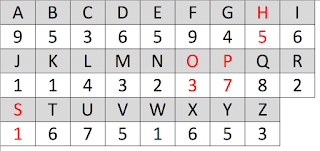Here is what's recommended by some banks as an aid to remembering a PIN number. Let's say your PIN is 1537. Make a grid of letters as shown below and decide on a word with the same number of letters as the PIN. For example, choose SHOP and then be careful to assign the number 1 to S, 5 to H, 3 to O and 7 to P. Thereafter, assign random numbers to the remaining letters.
All that is needed to retrieve the PIN then is to refer to the card. Of course, the relevant letters and numbers are not marked in red as they are here and so if the card falls into the wrong hands, it's not of any use.
An alternative is the PINFRUIT method in which letters, specifically consonants, are assigned to the numerals 0 to 9.
In this case, 1537 could be encoded as the words dolly mug with the associated image as shown below:
The image of Dolly Parton on a mug should be sufficient to recall the PIN number once the phrase dolly mug is retrieved. Of course, the PINFRUIT system takes a little getting used to but once mastered, it is easy to apply to any set of numbers that one encounters.
One can take this a step further and assign images to all number pairs between 00 and 99. In this system, the number pairs have preassigned words as shown below:
In this system, 1537 would correspond to towel hammock and so an image of a towel resting on a hammock should be sufficient to retrieve the PIN.
If one intends to use the PINFRUIT system on a long term basis, then it's probably better to follow the latter system so that words don't have to be made up on the fly. A memory palace can then be populated with the images of words drawn from the 00 to 99 grid and applied to any number of numerals.
For example, suppose one needs to remember the number 9948621987363. Firstly, divide the number into pairs moving right to left. The result is:
09 94 86 21 98 73 63
It is vital for numbers with an odd number of digits that the pairing process proceeds from right to left so that a leading zero can be applied. Referring to the 00-99 grid, the following words are generated from these number pairs:
soup - eyebrow - fish - hand - buff - comb - jam
A story or synthesised image can be then be generated for this sequence of words. For example, the following synthesised image works from the inside out:
It doesn't matter how odd the image is that is generated. In fact, the odder it is, the easier it will be to remember it.





